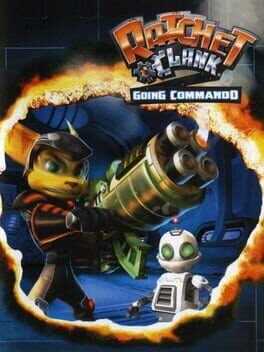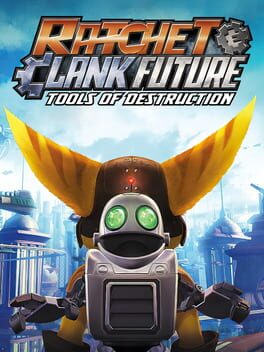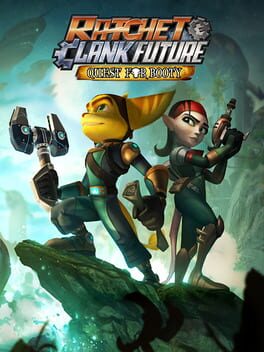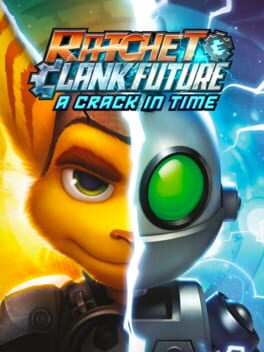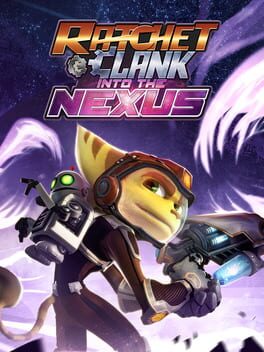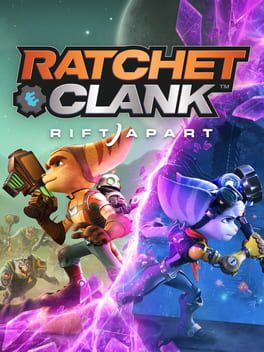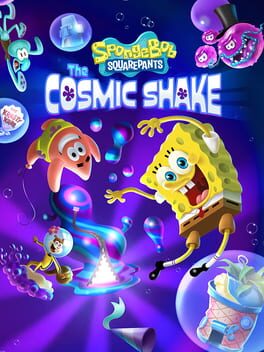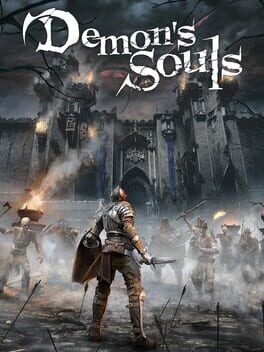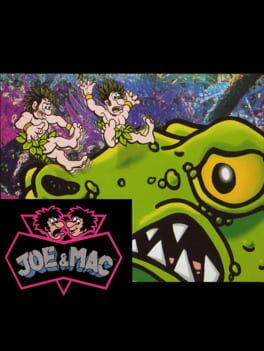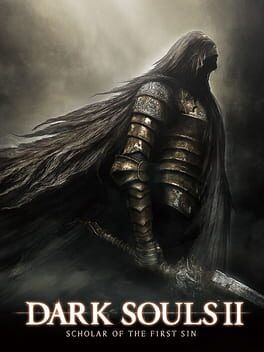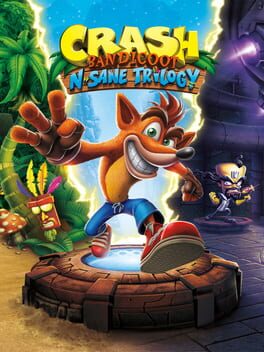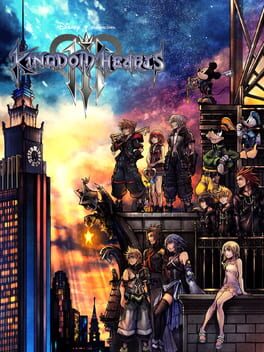RandomContent
2002
It would inspire much better games, and that's the best thing I can say about it.
I don't hate this game: I loved it when I was younger, but it just got worse every time I came back to it. The level design, is solid, it controls well enough, the soundtrack fits the aesthetic, and all-in-all the game is still playable.
However, the original Ratchet and Clank has a generic and badly-told story, the selection of weapons is easily the worst in the series, the main character sucks, the tone and pacing are inconsistent, and I'm not a fan of most of the writing.
As I said, the game is still playable, which is more than I can say for some other two-decade old games, but I don't see myself revisiting this one any time soon. Fortunately, there are some much better R&C games I'll get to revisit soon.
I don't hate this game: I loved it when I was younger, but it just got worse every time I came back to it. The level design, is solid, it controls well enough, the soundtrack fits the aesthetic, and all-in-all the game is still playable.
However, the original Ratchet and Clank has a generic and badly-told story, the selection of weapons is easily the worst in the series, the main character sucks, the tone and pacing are inconsistent, and I'm not a fan of most of the writing.
As I said, the game is still playable, which is more than I can say for some other two-decade old games, but I don't see myself revisiting this one any time soon. Fortunately, there are some much better R&C games I'll get to revisit soon.
Still the best.
As a guy who thinks the first R&C doesn't hold up very well, I think this one holds up spectacularly. Going Commando fixed every single problem I had with the first game and installed so many of the franchise hallmarks that are still present in the series today. I'll give the first game credit for creating the formula. But, if you ask me, this game deserves credit for perfecting it and putting these games on the map.
The controls are much better: I can finally strafe! The banal weapon selection from the first game was overhauled into an amazing selection of creative weapons that became more addicting to use due to the weapon upgrade system which would be featured in every game in the series henceforth. There is great gameplay variety as well: I can play the racing, arena, and crystal collection sections for hours(and I do): It is very impressive how this game adds so much variety without shattering the core gameplay loop in an obtrusive way. The fact that they are optional is objectively good, but I'd play them all anyway. After all, with 100% completion as excellent as this it is no trouble to get every clever skill point or devilishly-hidden platinum bolt leading up to the excellent hidden museum reward.
To be fair, the writing hasn't much improved unless you count all of it. Going Commando has a really fun, unique story that doesn't remind me of any other video game narrative, and it is the only game in the series not to use the exact same structure of, 'lengthy, contrived series of events to hunt down an obvious bad guy in an inefficient way.' The game is filled with quirky humor and memorable characters. The charm in this game is palpable, Ratchet is no-longer the worst main character ever, and the game features Ratchet's first, and easily best, love interest. Seriously, I never got over the series writing her out after this installment. I'm not too hopeful, but I'd love to see her again.
My problems with the game are very minor: I really like most of the optional content, but I wasn't crazy about the dogfights or the giant Clank sections; Most boss fights are very easy and basic; And the fact that the development became rushed near the end does show. The final few levels are weaker and the conclusion is rushed. But, honestly, who cares? This game is amazing.
In fact, much of this adulation may sound familiar to another Insomniac Game I bent over backwards to praise. The wonderful side-characters, the excellent 100% completion, the fantastic level design with the captivating worlds and quirky charm? To me, this game is the closest Insomniac has ever gotten to recapturing the original Spyro 2. I see so much of that game in this one. And, while I don't like Going Commando quite as much, it is another game I wouldn't have wanted to grow up without.
I don't know if this series will ever reach these same heights again. But, as long as I have this game to come back to, that's fine with me.
But seriously. Bring Angela back! #SaveAngela
As a guy who thinks the first R&C doesn't hold up very well, I think this one holds up spectacularly. Going Commando fixed every single problem I had with the first game and installed so many of the franchise hallmarks that are still present in the series today. I'll give the first game credit for creating the formula. But, if you ask me, this game deserves credit for perfecting it and putting these games on the map.
The controls are much better: I can finally strafe! The banal weapon selection from the first game was overhauled into an amazing selection of creative weapons that became more addicting to use due to the weapon upgrade system which would be featured in every game in the series henceforth. There is great gameplay variety as well: I can play the racing, arena, and crystal collection sections for hours(and I do): It is very impressive how this game adds so much variety without shattering the core gameplay loop in an obtrusive way. The fact that they are optional is objectively good, but I'd play them all anyway. After all, with 100% completion as excellent as this it is no trouble to get every clever skill point or devilishly-hidden platinum bolt leading up to the excellent hidden museum reward.
To be fair, the writing hasn't much improved unless you count all of it. Going Commando has a really fun, unique story that doesn't remind me of any other video game narrative, and it is the only game in the series not to use the exact same structure of, 'lengthy, contrived series of events to hunt down an obvious bad guy in an inefficient way.' The game is filled with quirky humor and memorable characters. The charm in this game is palpable, Ratchet is no-longer the worst main character ever, and the game features Ratchet's first, and easily best, love interest. Seriously, I never got over the series writing her out after this installment. I'm not too hopeful, but I'd love to see her again.
My problems with the game are very minor: I really like most of the optional content, but I wasn't crazy about the dogfights or the giant Clank sections; Most boss fights are very easy and basic; And the fact that the development became rushed near the end does show. The final few levels are weaker and the conclusion is rushed. But, honestly, who cares? This game is amazing.
In fact, much of this adulation may sound familiar to another Insomniac Game I bent over backwards to praise. The wonderful side-characters, the excellent 100% completion, the fantastic level design with the captivating worlds and quirky charm? To me, this game is the closest Insomniac has ever gotten to recapturing the original Spyro 2. I see so much of that game in this one. And, while I don't like Going Commando quite as much, it is another game I wouldn't have wanted to grow up without.
I don't know if this series will ever reach these same heights again. But, as long as I have this game to come back to, that's fine with me.
But seriously. Bring Angela back! #SaveAngela
My feelings about this game, especially with regards to the other two, are pretty easy to sum up: I like it quite a bit more than the first game, and quite a bit less than the second.
The whacky, unconventional story and memorable side characters from Going Commando are mostly gone. Up Your Arsenal instead opts for a pretty generic story with plenty of plot holes and mostly re-used characters I didn't even like that much in their first appearances, echoing many of my problems with the first game. Most of the new cast is either totally forgettable or memorable for the wrong reasons. Thank goodness this game brought us Dr. Nefarious and Lawrence, otherwise I'd have nothing positive to say in the writing department.
With that said, Dr. Nefarious is a perfect antagonist for a Ratchet and Clank game: walking a perfect line between being genuinely hilarious and a legitimate threat. His vocal performance is excellent, he has most of the best lines in the game, and his range of motion and animations are very impressive for the PS2 era. Also, Lawrence is underrated. His lines and vocal delivery are also excellent, and the schtick between him and Nefarious is gold: Nefarious wouldn't be the legend he is without his butler.
Still, the quality of the game's humor is very inconsistent, for every genuine laugh, there is a painful groaner, and the humor has a mean-spirited tinge I really don't care for. There are a few character moments that sound good on paper, but the game's conclusion is so rushed, none of them are able to resonate the way they should.
So, I didn't care for the story, characters, or writing. Thankfully, the gameplay is still up to standard. The game has an excellent selection of weapons, strong enemy variety, and an addictive gameplay loop that does its predecessor justice. In addition to satisfying combat in story missions, there is also an addictive arena section, a decent hacking mini-game, and a surprisingly-fun video-game-within-the-video-game that add welcome variety without overstaying their welcomes. With that said, there were a number of curious downgrades: the crystal collection mini-game is much worse due to the lack of visibility and repetitive enemies, most levels lend themselves less to exploration than previous games, and the sheer number of enemy-wave shootout sequences in the game can become tedious after a while. Still a strong gameplay loop, just lacking the polish and variety of Going Commando.
In summary, Up Your Arsenal is a really good podcast game: Strong gameplay with occasional hiccups and weak writing with occasional brilliance. I certainly wouldn't call it Insomniac's best, but I would call is a really fun time.
The whacky, unconventional story and memorable side characters from Going Commando are mostly gone. Up Your Arsenal instead opts for a pretty generic story with plenty of plot holes and mostly re-used characters I didn't even like that much in their first appearances, echoing many of my problems with the first game. Most of the new cast is either totally forgettable or memorable for the wrong reasons. Thank goodness this game brought us Dr. Nefarious and Lawrence, otherwise I'd have nothing positive to say in the writing department.
With that said, Dr. Nefarious is a perfect antagonist for a Ratchet and Clank game: walking a perfect line between being genuinely hilarious and a legitimate threat. His vocal performance is excellent, he has most of the best lines in the game, and his range of motion and animations are very impressive for the PS2 era. Also, Lawrence is underrated. His lines and vocal delivery are also excellent, and the schtick between him and Nefarious is gold: Nefarious wouldn't be the legend he is without his butler.
Still, the quality of the game's humor is very inconsistent, for every genuine laugh, there is a painful groaner, and the humor has a mean-spirited tinge I really don't care for. There are a few character moments that sound good on paper, but the game's conclusion is so rushed, none of them are able to resonate the way they should.
So, I didn't care for the story, characters, or writing. Thankfully, the gameplay is still up to standard. The game has an excellent selection of weapons, strong enemy variety, and an addictive gameplay loop that does its predecessor justice. In addition to satisfying combat in story missions, there is also an addictive arena section, a decent hacking mini-game, and a surprisingly-fun video-game-within-the-video-game that add welcome variety without overstaying their welcomes. With that said, there were a number of curious downgrades: the crystal collection mini-game is much worse due to the lack of visibility and repetitive enemies, most levels lend themselves less to exploration than previous games, and the sheer number of enemy-wave shootout sequences in the game can become tedious after a while. Still a strong gameplay loop, just lacking the polish and variety of Going Commando.
In summary, Up Your Arsenal is a really good podcast game: Strong gameplay with occasional hiccups and weak writing with occasional brilliance. I certainly wouldn't call it Insomniac's best, but I would call is a really fun time.
2005
When I revisited the main line R&C games, I was convinced my least favorite would either be the first game or the 2016 remake... HOWEVER:
Dreadlocked was appropriately dreadful to play. The side characters were all either completely forgettable or actively frustrating; the levels are banal, repetitive, and washed-out; the story is relentlessly downbeat and unpleasant but still has the occasional tone-killing joke; and any sense of exploration or puzzle-solving from the previous games is completely gone. The weapon selection is a big step down from the previous two games, and the only new weapon I particularly liked was the flail: I don't even remember the rest. The villain is just Chairman Drek without any of the charm or charisma. Ace Hardlight, the game's only potentially-interesting new character doesn't get enough screen time to leave an impression, and his actions don't always make sense in context. This is a really bad game.
True, the game still has R&C's trademark strong gameplay, even if it is watered down and unvaried compared to previous games. There were a few strong character moments, and I did count three funny moments (two were at the end). The gameplay is still adequate whenever the game isn't glitching or crashing. And, as stated previously, the flail is really fun to use. So, is all that enough for me to recommend this game? Oh, hell no.
Dreadlocked is the purest example of a bad Ratchet and Clank game: tone problems, no variety, taking itself too seriously, bad side-characters, and having no sense of wonder or fun. This game makes me feel bad that I complained about any of the games in the original trilogy: If there's one reason to be glad I played Dreadlocked, it made me appreciate those games more. Still, if that's the best thing I can say about Dreadlocked, then I have no problem calling it my least favorite in the series.
Dreadlocked was appropriately dreadful to play. The side characters were all either completely forgettable or actively frustrating; the levels are banal, repetitive, and washed-out; the story is relentlessly downbeat and unpleasant but still has the occasional tone-killing joke; and any sense of exploration or puzzle-solving from the previous games is completely gone. The weapon selection is a big step down from the previous two games, and the only new weapon I particularly liked was the flail: I don't even remember the rest. The villain is just Chairman Drek without any of the charm or charisma. Ace Hardlight, the game's only potentially-interesting new character doesn't get enough screen time to leave an impression, and his actions don't always make sense in context. This is a really bad game.
True, the game still has R&C's trademark strong gameplay, even if it is watered down and unvaried compared to previous games. There were a few strong character moments, and I did count three funny moments (two were at the end). The gameplay is still adequate whenever the game isn't glitching or crashing. And, as stated previously, the flail is really fun to use. So, is all that enough for me to recommend this game? Oh, hell no.
Dreadlocked is the purest example of a bad Ratchet and Clank game: tone problems, no variety, taking itself too seriously, bad side-characters, and having no sense of wonder or fun. This game makes me feel bad that I complained about any of the games in the original trilogy: If there's one reason to be glad I played Dreadlocked, it made me appreciate those games more. Still, if that's the best thing I can say about Dreadlocked, then I have no problem calling it my least favorite in the series.
I want to love this game, but I can only like it.
The story seemed epic and impactful in concept, but there are so many tone-killing jokes and questionable detours in the story that it just doesn't resonate as well as it should. The side characters aren't well incorporated into the story, a number of plot points really aren't explained well, and there are a fair share of plot holes. ToD could have been a great space epic, but there were just too many rough edges that weren't ironed out.
The gameplay is great, for the most part. The six axis controls are gimmicky and frustrating, and the selection of guns isn't as good as R&C 2 or 3, but, for everything else, this was a blast to play. The excellent presentation adds so much to R&C's already strong gameplay loop. The satisfying crunch of broken boxes, the detailed enemy designs, the explorable open worlds rife with creative layouts and rewarding collectables. I don't normally place too much stock in a game's presentation, but Ratchet & Clank have had a huge role in pushing the envelope for 3D platformers in that regard. And, while I would still like this game fine even if it looked like trash, I like it so much more because it doesn't.
Tools of Destruction never lived up to its potential, but it was a fun time regardless. If you're a R&C fan, this is one to check out.
The story seemed epic and impactful in concept, but there are so many tone-killing jokes and questionable detours in the story that it just doesn't resonate as well as it should. The side characters aren't well incorporated into the story, a number of plot points really aren't explained well, and there are a fair share of plot holes. ToD could have been a great space epic, but there were just too many rough edges that weren't ironed out.
The gameplay is great, for the most part. The six axis controls are gimmicky and frustrating, and the selection of guns isn't as good as R&C 2 or 3, but, for everything else, this was a blast to play. The excellent presentation adds so much to R&C's already strong gameplay loop. The satisfying crunch of broken boxes, the detailed enemy designs, the explorable open worlds rife with creative layouts and rewarding collectables. I don't normally place too much stock in a game's presentation, but Ratchet & Clank have had a huge role in pushing the envelope for 3D platformers in that regard. And, while I would still like this game fine even if it looked like trash, I like it so much more because it doesn't.
Tools of Destruction never lived up to its potential, but it was a fun time regardless. If you're a R&C fan, this is one to check out.
I'll bet you forgot this one existed.
As far as entire games that obviously should have been DLCs go, this one sure is an entire game which obviously should have been a DLC. The island aesthetic is beautiful, the writing is entertaining, and it keeps Tools of Destruction's strong gameplay loop while also adding some nice platforming challenges and offering a more consistent tone and fitting story. I can think to my self, 'wow, I might really end up loving this ga-' and then it ends.
Quest for Booty is a delectable side-course, but a flimsy main entrée. It's also worth mentioning that I played Crack in Time for the first time without playing Quest for Booty, and I was able to follow the story just fine.
Play it or skip it, you're fine either way.
As far as entire games that obviously should have been DLCs go, this one sure is an entire game which obviously should have been a DLC. The island aesthetic is beautiful, the writing is entertaining, and it keeps Tools of Destruction's strong gameplay loop while also adding some nice platforming challenges and offering a more consistent tone and fitting story. I can think to my self, 'wow, I might really end up loving this ga-' and then it ends.
Quest for Booty is a delectable side-course, but a flimsy main entrée. It's also worth mentioning that I played Crack in Time for the first time without playing Quest for Booty, and I was able to follow the story just fine.
Play it or skip it, you're fine either way.
Was Lord Vorselon actually Ratchet's Father's accountant? I'm legitimately curious.
The third time was the charm for the R&C Future games, because this one is great. Having been pretty underwhelmed with the previous two for their underwhelming gun selections, lack on interesting platforming sections, and gimmicky six-axis controls; I was delighted to dive back in to A Crack in Time: A game that fixed all of those problems among others.
The selection of guns in this game is the best since Up Your Arsenal, the platforming challenges are varied and compelling, the puzzles are numerous and add welcome variety and depth to the gameplay, and the hover-boots make traversal quick and seamless. If sheer gameplay were the only factor, this one would be my favorite.
The story, despite a few problems, is still better told and better paced than the average R&C game. Dr. Nefarious is funny as always and adds welcome levity to the narrative, the tone is more mature and emotionally resonant than any other game to date, it addresses a few plot holes from Tools of Destruction , and it has easily one of the best characters in the series: his backstory is tragic, his methods are extreme but understandable, he has a good design and excellent vocal performance, and his relationship with Ratchet is really strong. I'm sad that this game was his only appearance. Honestly, Crack in Time is such a strong package that I was ready to give it a nine out of ten and say it was tied for my favorite in the series. but...
The two worst things out of any Future game are in this game, and they both relate to the story. I can't even attempt to discus them without going into spoilers, so stop reading here unless you've played the game.
Problem 1) The Plot Hole: literally the only rule regarding the Great Clock is 'don't use it as a time machine'. They do that three times. They say you can't use it to open a rift to stop a genocidal lunatic years ago and save the Lombaxes, which is weird because they used it to open a rift to stop a genocidal lunatic years ago to save the Fongoids. Azimuth was completely right and this plot development makes his sacrifice seem pointless.
Problem 2) The Ending: The whole point of the game was about accepting that things change and you can't always fix or stop them. Ratchet and Clank spent the entire game learning to be independent from each other and make the universe a better place in their own way. The ending throws all that out and has Clank shrug off his responsibility in the Great Clock just so the game can be left open to a sequel. Honestly, if the ending were better, I would have said this was a good note to end the series on, but this ending makes the entire Future Trilogy feel pointless, and it makes me hesitant when I'm thinking of popping this game in.
Crack in Time may have tripped at the finish line, but I still loved it at least 80% of the time, and I'll still happily recommend. It may not be a perfect game, but it's a damn good one.
The third time was the charm for the R&C Future games, because this one is great. Having been pretty underwhelmed with the previous two for their underwhelming gun selections, lack on interesting platforming sections, and gimmicky six-axis controls; I was delighted to dive back in to A Crack in Time: A game that fixed all of those problems among others.
The selection of guns in this game is the best since Up Your Arsenal, the platforming challenges are varied and compelling, the puzzles are numerous and add welcome variety and depth to the gameplay, and the hover-boots make traversal quick and seamless. If sheer gameplay were the only factor, this one would be my favorite.
The story, despite a few problems, is still better told and better paced than the average R&C game. Dr. Nefarious is funny as always and adds welcome levity to the narrative, the tone is more mature and emotionally resonant than any other game to date, it addresses a few plot holes from Tools of Destruction , and it has easily one of the best characters in the series: his backstory is tragic, his methods are extreme but understandable, he has a good design and excellent vocal performance, and his relationship with Ratchet is really strong. I'm sad that this game was his only appearance. Honestly, Crack in Time is such a strong package that I was ready to give it a nine out of ten and say it was tied for my favorite in the series. but...
The two worst things out of any Future game are in this game, and they both relate to the story. I can't even attempt to discus them without going into spoilers, so stop reading here unless you've played the game.
Problem 1) The Plot Hole: literally the only rule regarding the Great Clock is 'don't use it as a time machine'. They do that three times. They say you can't use it to open a rift to stop a genocidal lunatic years ago and save the Lombaxes, which is weird because they used it to open a rift to stop a genocidal lunatic years ago to save the Fongoids. Azimuth was completely right and this plot development makes his sacrifice seem pointless.
Problem 2) The Ending: The whole point of the game was about accepting that things change and you can't always fix or stop them. Ratchet and Clank spent the entire game learning to be independent from each other and make the universe a better place in their own way. The ending throws all that out and has Clank shrug off his responsibility in the Great Clock just so the game can be left open to a sequel. Honestly, if the ending were better, I would have said this was a good note to end the series on, but this ending makes the entire Future Trilogy feel pointless, and it makes me hesitant when I'm thinking of popping this game in.
Crack in Time may have tripped at the finish line, but I still loved it at least 80% of the time, and I'll still happily recommend. It may not be a perfect game, but it's a damn good one.
If Tools of Destruction and Quest for Booty were done better.
Into the Nexus takes its main plot and most of its plot elements and gameplay mechanics from Tools of destruction, but it also refines them, creating a game with strong level design, intimidating and well-established villains, a strong gameplay loop with no major low points, and a story that is well told; well paced; and free from major plot holes.
Quest for Booty's short length held it back because it had too many recycled elements from the previous game and too underwhelming a story for it to be memorable. Into the Nexus has a distinct story with distinct characters and meaningful plot events that stand on their own. Nexus can be described as a compact and polished chapter in the R&C saga, where Quest for Booty felt more like a redundant side-note.
Unfortunately, Nexus didn't deliver any major refinements to the R&C formula: The story is functional but nothing special, the gameplay is fun but not drastically better than any game before, and while the short length isn't a major problem, this is the only game in the series I do wish was longer as many of the ideas and characters could have been fleshed out more. It is better to want more than less, but Nexus still ends before a truly great impression has been made.
I still recommend into Nexus. It may only be five hours, but it is five hours well-spent.
Into the Nexus takes its main plot and most of its plot elements and gameplay mechanics from Tools of destruction, but it also refines them, creating a game with strong level design, intimidating and well-established villains, a strong gameplay loop with no major low points, and a story that is well told; well paced; and free from major plot holes.
Quest for Booty's short length held it back because it had too many recycled elements from the previous game and too underwhelming a story for it to be memorable. Into the Nexus has a distinct story with distinct characters and meaningful plot events that stand on their own. Nexus can be described as a compact and polished chapter in the R&C saga, where Quest for Booty felt more like a redundant side-note.
Unfortunately, Nexus didn't deliver any major refinements to the R&C formula: The story is functional but nothing special, the gameplay is fun but not drastically better than any game before, and while the short length isn't a major problem, this is the only game in the series I do wish was longer as many of the ideas and characters could have been fleshed out more. It is better to want more than less, but Nexus still ends before a truly great impression has been made.
I still recommend into Nexus. It may only be five hours, but it is five hours well-spent.
Best-looking video game ever.
The 11/10 score I'd give this game for presentation alone makes it worth every penny. The fluid motions, realized landscapes, and vivid textures paint a picture even the modern Pixar film would blush at. Ratchet and Clank has always pushed the envelope for video games with regards to presentation, and Rift Apart is their greatest accomplishment in that regard.
For everything ese the game is... good. It has a very weak and predictable story, though it is better paced and better told than the average R&C game. The level designs are great, the enemy variety is lacking, and the gun selection is average by the series' standers: though all three borrow just a bit too much from previous games. The gameplay variety and exploration are acceptable, though a step down from Crack in Time in my opinion. Lastly, the writing was forgettable: I remember almost nothing said by any character and I don't think I laughed once.
Rift Apart is a typical R&C affair but still a fun one. For many people, it was their first PS5 title, and I think it is a great way to be exposed to the console.
Jim Ward, you will be missed: I wish you a fulfilling retirement.
The 11/10 score I'd give this game for presentation alone makes it worth every penny. The fluid motions, realized landscapes, and vivid textures paint a picture even the modern Pixar film would blush at. Ratchet and Clank has always pushed the envelope for video games with regards to presentation, and Rift Apart is their greatest accomplishment in that regard.
For everything ese the game is... good. It has a very weak and predictable story, though it is better paced and better told than the average R&C game. The level designs are great, the enemy variety is lacking, and the gun selection is average by the series' standers: though all three borrow just a bit too much from previous games. The gameplay variety and exploration are acceptable, though a step down from Crack in Time in my opinion. Lastly, the writing was forgettable: I remember almost nothing said by any character and I don't think I laughed once.
Rift Apart is a typical R&C affair but still a fun one. For many people, it was their first PS5 title, and I think it is a great way to be exposed to the console.
Jim Ward, you will be missed: I wish you a fulfilling retirement.
Battle for Bikini Bottom this is not.
Cosmic Shake made me appreciate BfBB a lot more: The hallway level design with no room for exploration made me appreciate how expansive BfBB's levels were; the confusing, overelaborate narrative of Cosmic Shake made me long for BfBB's elegant simplicity; CS's abundance of forgettable, tacked-on minigames and side-modes made me remember BfBB's excellent gameplay balance; and the lameness of Cosmic Shake's boss roster made me long for the grandeur of Robot Patrick.
I was re-watching classic Spongebob a few weeks ago and a season four episode somehow got mixed in with season three. I watched it, and the downgrade in quality was immediately apparent. The episode, while decent, was so much more generic, had less heart, and just wasn't as funny. It made me remember how special Classic Spongebob was: the first three seasons truly were lightening in a bottle and it's important not to take them for granted. The later seasons have their moments, but the magic of the classic series can never truly be re-captured. That's essentially how I feel about Battle for Bikini Bottom vs Cosmic Shake.
Cosmic Shake is a fine way to spend a few hours if you're a diehard fan. But, if you go in expecting something that will live up to Battle for Bikini Bottom, you'll be disappointed.
Cosmic Shake made me appreciate BfBB a lot more: The hallway level design with no room for exploration made me appreciate how expansive BfBB's levels were; the confusing, overelaborate narrative of Cosmic Shake made me long for BfBB's elegant simplicity; CS's abundance of forgettable, tacked-on minigames and side-modes made me remember BfBB's excellent gameplay balance; and the lameness of Cosmic Shake's boss roster made me long for the grandeur of Robot Patrick.
I was re-watching classic Spongebob a few weeks ago and a season four episode somehow got mixed in with season three. I watched it, and the downgrade in quality was immediately apparent. The episode, while decent, was so much more generic, had less heart, and just wasn't as funny. It made me remember how special Classic Spongebob was: the first three seasons truly were lightening in a bottle and it's important not to take them for granted. The later seasons have their moments, but the magic of the classic series can never truly be re-captured. That's essentially how I feel about Battle for Bikini Bottom vs Cosmic Shake.
Cosmic Shake is a fine way to spend a few hours if you're a diehard fan. But, if you go in expecting something that will live up to Battle for Bikini Bottom, you'll be disappointed.
2020
1991
I can deny it no longer: I like Dark Souls 2
Is the game amazing? No. Is it the weakest game of the trilogy? By a Lordran mile. Is it the worst FromSoft game due to its nonsensical enemy placement and bad level design? Actually no, have you played Demon's Souls?
Flaws aside, I don't want to sell Dark Souls 2 short. The attention to detail in this game is really admirable; finding all the shortcuts and hidden bonfires was always satisfying. All three DLC campaigns were strong, and the classic Souls combat and character building is as satisfying as ever, bolstered by worthwhile collectables and strong enemy variety.
The level design of Dark Souls 2 is excellent. If there is anything DS2 is the best of the trilogy for, it would be that. The levels don't feel as interconnected as in the previous game, but the endless hidden secrets, fair progression, and wealth of variety in themes and enemies made each location memorable and enthralling.
I won't pretend the critics of this game don't have a point: I didn't find the lore interesting, far too many ideas are lifted from the previous game, some graphics and designs can be banal and ugly. The game is also abundant in bad hit boxes, lame boss fights, and nonsensical enemy placement. DS2, while a worthy undertaking for sure, is unpolished at the best of times.
Darks Souls 2 deserves its bad reputation to a degree, but the positive aspects shouldn't be overlooked. If this installment truly ranks among FromSoft's weakest work, then they must be an amazing studio.
Is the game amazing? No. Is it the weakest game of the trilogy? By a Lordran mile. Is it the worst FromSoft game due to its nonsensical enemy placement and bad level design? Actually no, have you played Demon's Souls?
Flaws aside, I don't want to sell Dark Souls 2 short. The attention to detail in this game is really admirable; finding all the shortcuts and hidden bonfires was always satisfying. All three DLC campaigns were strong, and the classic Souls combat and character building is as satisfying as ever, bolstered by worthwhile collectables and strong enemy variety.
The level design of Dark Souls 2 is excellent. If there is anything DS2 is the best of the trilogy for, it would be that. The levels don't feel as interconnected as in the previous game, but the endless hidden secrets, fair progression, and wealth of variety in themes and enemies made each location memorable and enthralling.
I won't pretend the critics of this game don't have a point: I didn't find the lore interesting, far too many ideas are lifted from the previous game, some graphics and designs can be banal and ugly. The game is also abundant in bad hit boxes, lame boss fights, and nonsensical enemy placement. DS2, while a worthy undertaking for sure, is unpolished at the best of times.
Darks Souls 2 deserves its bad reputation to a degree, but the positive aspects shouldn't be overlooked. If this installment truly ranks among FromSoft's weakest work, then they must be an amazing studio.
Instead of reviewing these games, here is a boss ranking:
Every boss gets a score out of five:
16: Dr. Cortex
Game: Crash 2
Score: 0/5
The namesake boss of Crash 2 is an embarrassment; I'm not even comfortable calling it a boss. He never attacks you and there is no remote element of combat. The boss is tedious if you don’t know what to do, and pitiful easy if you do; It still blows my mind how bad this boss is.
15: Papu Papu
Game: Crash 1
Score: 1/5
Objectively just as bad as the previous fight, but at least he attacks you, and he has the excuse of being the first boss of the first game. Still a terrible note to start on.
14: Ripper Roo
Game: Crash 1
Score: 1/5
Still no element of combat. A unique setup can’t make up for this boss feeling more like a level hazard; the timing on the TNT crates can be irritating as well. Fortunately, there is another boss further down the list that uses Ripper Roo’s setup much better.
13: Ripper Roo
Game: Crash 2
Score: 2/5
Really not a big fan of Ripper Roo boss fights. This one has more interesting attacks and slightly better aesthetics, but still just feels like a level hazard and is really boring on future playthroughs.
12: Komodo Bros
Game: Crash 2
Score: 2/5
This fight would rank much higher if not for one thing; the area is too big. It’s almost impossible to get hit by anything, and there is no challenge as a result. Great aesthetics can’t make up for that unfortunately.
11: Pinstripe Potoroo
Game: Crash 1
Score: 2/5
You could lob the first half of his health bar off all at once in the original ps1 game. This version is slightly harder, but still too easy and basic to be noteworthy.
10: Tiny Tiger
Game: Crash 2
Score: 3/5
The second-best boss in Crash 2 barely made the top ten; Crash 2’s bosses aren’t very good. Tiny is a fine encounter; it takes Ripper Roo’s mechanics and improves them by having the boss actively pursue you. Tiny is fun, but very basic. The best thing about him by far is the music, which is common for Crash 2.
9: Koala Kong
Game: Crash 1
Score: 3/5
The first good boss in the series. I could almost tie Kong with Tiny, but I put Kong slightly higher because he has more attacks and slightly more complex mechanics. Kong is basic fun, nothing more, nothing less.
8: Dr. Cortex
Game: Crash 1
Score: 3/5
Dr. Cortex fights run the gambit in terms of quality. This one provides a worthy challenge and an appropriately epic setting for the game’s conclusion. I have no idea how the next Cortex fight was such a downgrade, but maybe the one after that will be way better.
7: N. Tropy
Game: Crash 3
Score: 3/5
The weakest fight in Crash 3 is in the upper half of the list; five of the top seven bosses in the trilogy are just Crash 3; That should tell you something about Crash 3’s boss quality compared to the previous two games.
Tropy is a solid fight. He has challenging attacks to dodge and the fight itself has good aesthetics. I’d be happy to rank it higher, but the rest of Crash 3’s bosses are just too good: Which reminds me…
6: N. Gin
Game: Crash 3
Score: 4/5
This fight is objectively the longest and most varied in the trilogy. Unfortunately, it also stands out as one of the very few that was notably better in the ps1 version: This fight is much easier, and you feel much less impact from damaging the parts of the robot. Still a great fight, but a bit of a downgrade.
5: N. Brio
Game: Crash 1
Score: 4/5
My favorite Crash character is also my favorite fight from Crash 1. Honestly, this fight is so varied and clever that it’s hard to believe it’s from the first game. The actual gameplay of this fight is nothing special, but the setting, mechanics, and the boss character are among the best in the trilogy.
4: Tiny Tiger
Game: Crash 3
Score: 4/5
Best first boss in the trilogy without question. Twinsanity and Crash 4 may have had better first bosses later on, but this one set a new standard with an excellent area, varied attacks, and being the first boss to give you an upgrade after defeating him. Tiny provides a challenge early on that doesn’t feel overwhelming given your place in the game. I have no idea how they’ll top this.
3: Dingodile
Game: Crash 3
Score: 5/5
They topped it. Wildly creative area and boss character, unique mechanics, and the best boss theme in the trilogy. The fact that you earn the double-jump from this fight, which can be used to cheese this fight on a second encounter, is just icing on the cake. This is probably one of the best bosses I’ve ever seen in a platforming game.
2: N. Gin
Game: Crash 2
Score: 5/5
The saving grace of Crash 2’s boss roster. N Gin has so many attacks, a great boss theme, a cool voice, a good design, and a fair challenge. His attacks will even vary depending on if he has one or two shoulders left. That attention to detail is admirable. Crash 2 would be right alongside Spyro 1 as a posterchild of good games with bad bosses if not for this encounter.
1: Neo Cortex
Game: Crash 3
Score: 5/5
Have you all figured out by now I really like Crash 3 bosses? Especially those with excellent music, varied attacks, memorable areas, and a climactic sense of scale? This fight has it all: an epic 2-v-2 encounter with two foes built-up throughout your entire journey, and one where you must win without taking damage due to Aku-Aku’s pre-occupation fighting his brother. Much like Spyro 2’s final boss, the added hurdle of winning with no damage adds a lot to the encounter and helps forgive the lack of difficulty. You can argue that N. Gin or Dingodile have the better gameplay, but I think Dr. Cortex’s Crash 3 fight is the complete package.
I reviewed each ps1 game individually and these game are just those with streamlined controls, better graphics, some dated elements of progression removed, and optional time trials across all three games. This trilogy is great, and you don't need me to tell you that.
Every boss gets a score out of five:
16: Dr. Cortex
Game: Crash 2
Score: 0/5
The namesake boss of Crash 2 is an embarrassment; I'm not even comfortable calling it a boss. He never attacks you and there is no remote element of combat. The boss is tedious if you don’t know what to do, and pitiful easy if you do; It still blows my mind how bad this boss is.
15: Papu Papu
Game: Crash 1
Score: 1/5
Objectively just as bad as the previous fight, but at least he attacks you, and he has the excuse of being the first boss of the first game. Still a terrible note to start on.
14: Ripper Roo
Game: Crash 1
Score: 1/5
Still no element of combat. A unique setup can’t make up for this boss feeling more like a level hazard; the timing on the TNT crates can be irritating as well. Fortunately, there is another boss further down the list that uses Ripper Roo’s setup much better.
13: Ripper Roo
Game: Crash 2
Score: 2/5
Really not a big fan of Ripper Roo boss fights. This one has more interesting attacks and slightly better aesthetics, but still just feels like a level hazard and is really boring on future playthroughs.
12: Komodo Bros
Game: Crash 2
Score: 2/5
This fight would rank much higher if not for one thing; the area is too big. It’s almost impossible to get hit by anything, and there is no challenge as a result. Great aesthetics can’t make up for that unfortunately.
11: Pinstripe Potoroo
Game: Crash 1
Score: 2/5
You could lob the first half of his health bar off all at once in the original ps1 game. This version is slightly harder, but still too easy and basic to be noteworthy.
10: Tiny Tiger
Game: Crash 2
Score: 3/5
The second-best boss in Crash 2 barely made the top ten; Crash 2’s bosses aren’t very good. Tiny is a fine encounter; it takes Ripper Roo’s mechanics and improves them by having the boss actively pursue you. Tiny is fun, but very basic. The best thing about him by far is the music, which is common for Crash 2.
9: Koala Kong
Game: Crash 1
Score: 3/5
The first good boss in the series. I could almost tie Kong with Tiny, but I put Kong slightly higher because he has more attacks and slightly more complex mechanics. Kong is basic fun, nothing more, nothing less.
8: Dr. Cortex
Game: Crash 1
Score: 3/5
Dr. Cortex fights run the gambit in terms of quality. This one provides a worthy challenge and an appropriately epic setting for the game’s conclusion. I have no idea how the next Cortex fight was such a downgrade, but maybe the one after that will be way better.
7: N. Tropy
Game: Crash 3
Score: 3/5
The weakest fight in Crash 3 is in the upper half of the list; five of the top seven bosses in the trilogy are just Crash 3; That should tell you something about Crash 3’s boss quality compared to the previous two games.
Tropy is a solid fight. He has challenging attacks to dodge and the fight itself has good aesthetics. I’d be happy to rank it higher, but the rest of Crash 3’s bosses are just too good: Which reminds me…
6: N. Gin
Game: Crash 3
Score: 4/5
This fight is objectively the longest and most varied in the trilogy. Unfortunately, it also stands out as one of the very few that was notably better in the ps1 version: This fight is much easier, and you feel much less impact from damaging the parts of the robot. Still a great fight, but a bit of a downgrade.
5: N. Brio
Game: Crash 1
Score: 4/5
My favorite Crash character is also my favorite fight from Crash 1. Honestly, this fight is so varied and clever that it’s hard to believe it’s from the first game. The actual gameplay of this fight is nothing special, but the setting, mechanics, and the boss character are among the best in the trilogy.
4: Tiny Tiger
Game: Crash 3
Score: 4/5
Best first boss in the trilogy without question. Twinsanity and Crash 4 may have had better first bosses later on, but this one set a new standard with an excellent area, varied attacks, and being the first boss to give you an upgrade after defeating him. Tiny provides a challenge early on that doesn’t feel overwhelming given your place in the game. I have no idea how they’ll top this.
3: Dingodile
Game: Crash 3
Score: 5/5
They topped it. Wildly creative area and boss character, unique mechanics, and the best boss theme in the trilogy. The fact that you earn the double-jump from this fight, which can be used to cheese this fight on a second encounter, is just icing on the cake. This is probably one of the best bosses I’ve ever seen in a platforming game.
2: N. Gin
Game: Crash 2
Score: 5/5
The saving grace of Crash 2’s boss roster. N Gin has so many attacks, a great boss theme, a cool voice, a good design, and a fair challenge. His attacks will even vary depending on if he has one or two shoulders left. That attention to detail is admirable. Crash 2 would be right alongside Spyro 1 as a posterchild of good games with bad bosses if not for this encounter.
1: Neo Cortex
Game: Crash 3
Score: 5/5
Have you all figured out by now I really like Crash 3 bosses? Especially those with excellent music, varied attacks, memorable areas, and a climactic sense of scale? This fight has it all: an epic 2-v-2 encounter with two foes built-up throughout your entire journey, and one where you must win without taking damage due to Aku-Aku’s pre-occupation fighting his brother. Much like Spyro 2’s final boss, the added hurdle of winning with no damage adds a lot to the encounter and helps forgive the lack of difficulty. You can argue that N. Gin or Dingodile have the better gameplay, but I think Dr. Cortex’s Crash 3 fight is the complete package.
I reviewed each ps1 game individually and these game are just those with streamlined controls, better graphics, some dated elements of progression removed, and optional time trials across all three games. This trilogy is great, and you don't need me to tell you that.
2019
This game committed an unforgivable crime, making me question if the previous games were that good to begin with.
It amazes me how flat the KH formula falls in this game. The storytelling is so bland and uncompelling, the characters so wooden and underutilized, and the tone alternates between overly serious and self-parody. The game is dominated by filler, leaving 80% of the best and most plot relevant moments for the very end. I don't want to play a game that doesn't become good until 20 hours in.
The gameplay is also too flashy and shallow, I struggle to remember any combat encouter in the game, and I fail to care. The optional content is easily the best in the game: Though it may be an amusing distraction, it saves nothing in the long run.
The game looks great, there are a few compelling character moments in the last third, and finding Mikey emblems is fun enough, but these things aren't nearly worth the tedious trek to reach them. Group all this together with the worst DLC campaign I've ever played, and KH3 has soured the entire franchise for me. I can't look at KH 1 or 2 the same way, and I have no interest in playing KH 4 when it comes out. This, to me, is another tragic instance of an inspired franchise being torn down by pandering and pretention.
KH3 needed to check its engine before slurging on a paint job.
It amazes me how flat the KH formula falls in this game. The storytelling is so bland and uncompelling, the characters so wooden and underutilized, and the tone alternates between overly serious and self-parody. The game is dominated by filler, leaving 80% of the best and most plot relevant moments for the very end. I don't want to play a game that doesn't become good until 20 hours in.
The gameplay is also too flashy and shallow, I struggle to remember any combat encouter in the game, and I fail to care. The optional content is easily the best in the game: Though it may be an amusing distraction, it saves nothing in the long run.
The game looks great, there are a few compelling character moments in the last third, and finding Mikey emblems is fun enough, but these things aren't nearly worth the tedious trek to reach them. Group all this together with the worst DLC campaign I've ever played, and KH3 has soured the entire franchise for me. I can't look at KH 1 or 2 the same way, and I have no interest in playing KH 4 when it comes out. This, to me, is another tragic instance of an inspired franchise being torn down by pandering and pretention.
KH3 needed to check its engine before slurging on a paint job.

